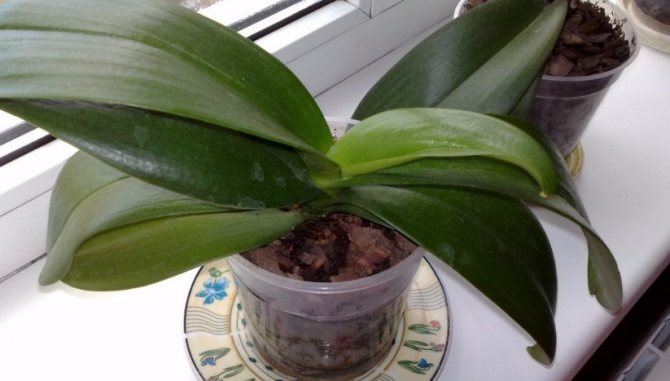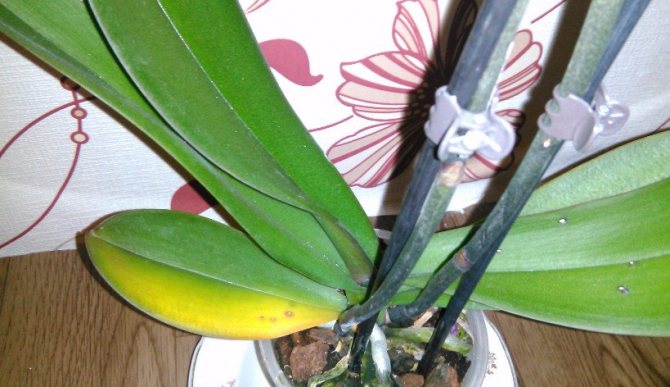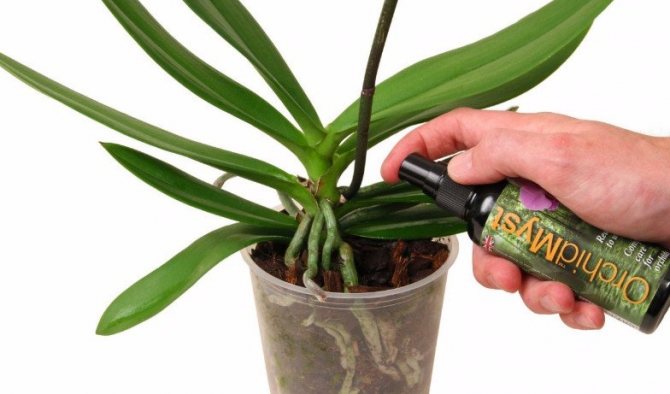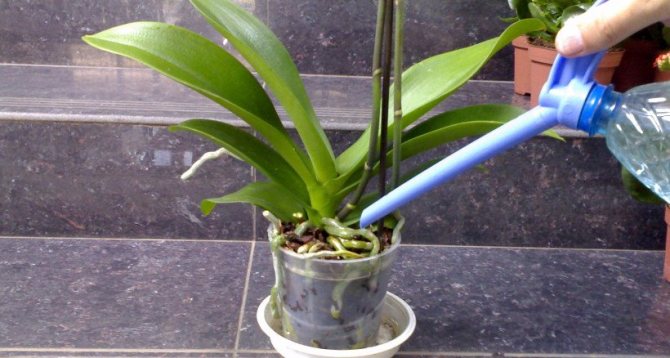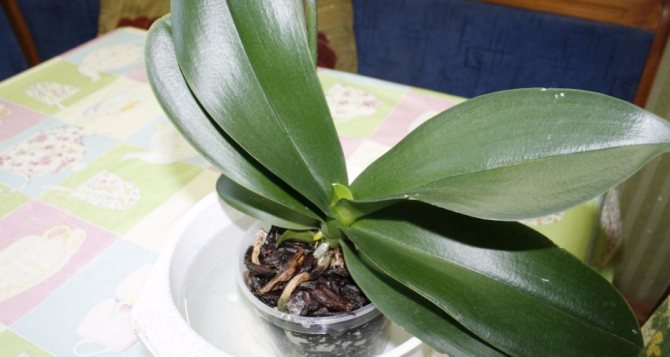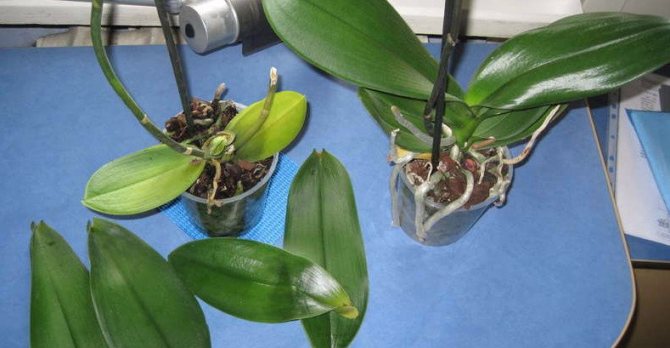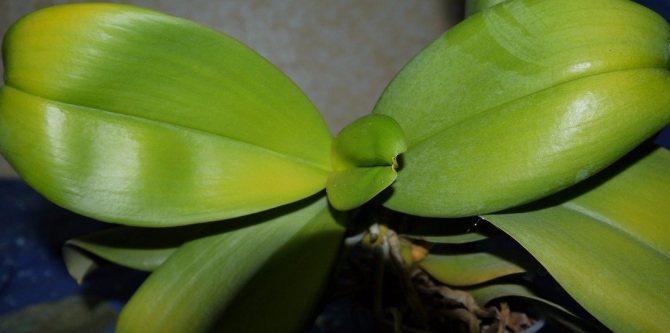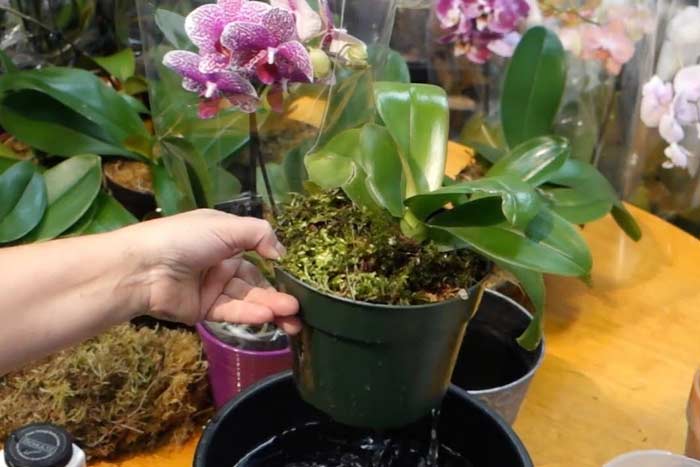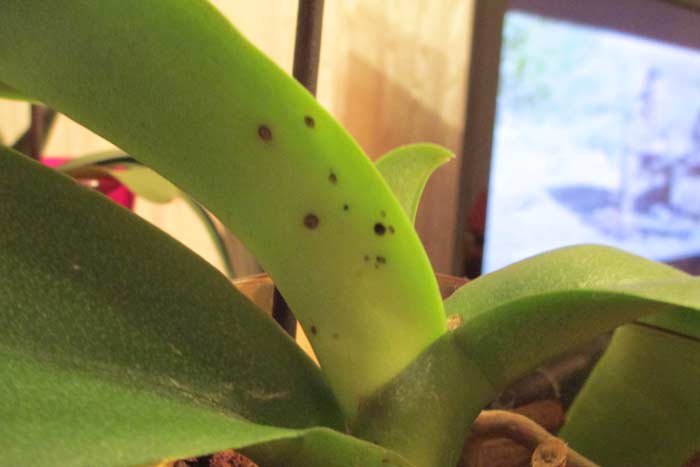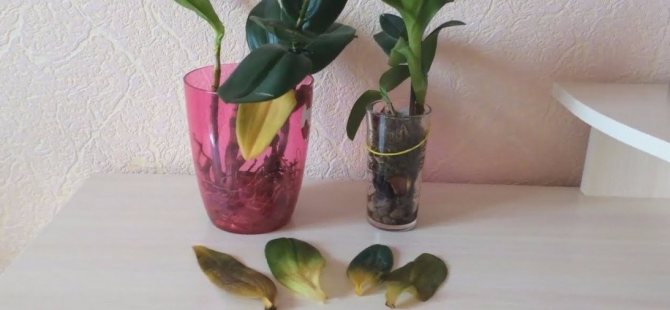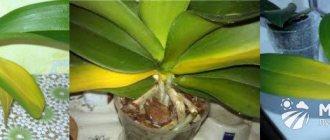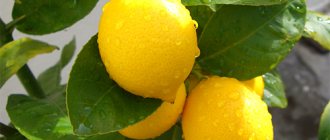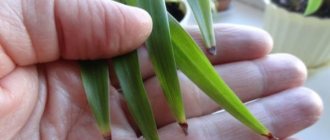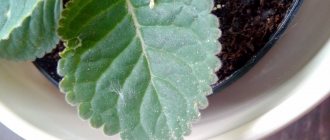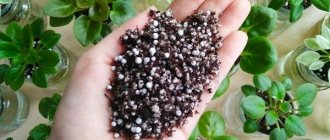Plants
05.07.2016 admin 10 166 views rotting, orchid, advice, care, flowers
Subscribe to
The beautiful orchid delights you with its flowering and beautiful appearance. But you have noticed that lately the leaves and the core of the flower are beginning to rot. The article will tell you about the reasons for this process, as well as about methods of control and prevention.
- 1 Causes of problems 1.1 Leaves rot
- 1.2 The core is rotting
Causes of damage
Trouble begins from excess moisture... Most often from overly generous or frequent watering, when the substrate in the pot is constantly getting wet. This leads to disruption of aeration, the roots suffocate, because of this, a failure occurs in the metabolic processes of the plant and it weakens. At the same time, in a humid environment, the growth and reproduction of fungal microorganisms - causative agents of diseases, is activated. When evaporated, pathogens rise into the air and settle on the leaves. First, plaque appears on the underside of the plate. He is often overlooked. But, when it gets inside the tissue, it hits the sheet through and through and appears from above. This is an indicator of the deep penetration of the infection. And when the spots turn into rot, it means that the defeat has entered the last stage.
The greatest danger is threatened by orchids when the leaf axils rot. In this case, the growth point is damaged - the base of the ground part. If it rots away, the orchid cannot be saved.
K. M. Shvarko - Art. n. from. Department of Tropical Herbaceous Perennials - Central Botanical Garden of the National Academy of Sciences of Belarus.

Leaf rotting causes excessive waterlogging.
Orchid rot is infectious diseases:
| Fusarium wilting | The disease is caused by fungi of the genus Fusarium oxysporum. It penetrates into the leaves through pores or wounds and clogs tissues. Yellow spots appear. If you do not take remedial measures, they rot. |
| Wet bacterial rot | Occurs as a result of the penetration of bacteria Acidovorax, Erwinia, Burkholderia gladioli. Pathogens are highly volatile and quickly spread not only through orchids, but also to neighboring plants. If symptoms are found, the flower must be urgently isolated. |
| Pythium | The insidiousness of the disease is that when rot appears on the leaves, it means that it has affected the root system and reached the ground part. Orchid leaves with pseudobulbs are affected last when the infection has passed through the roots and stems. |
| Late blight | Symptoms resemble pitium. Brown spots appear on the leaves, which quickly turn black and rot. The fungus actively spreads in conditions of high temperature and humidity. |
| Brown rot | It looks like watery spots that change from a transparent color to brown. The disease develops at low (for an orchid) temperature and high humidity. |
| Black rot | It occurs when the orchid is in the cold for a long time or after being damaged by pests. |
Pathogenic pathogens live in the substrate, are carried by air masses from one plant to another. They develop actively and pose a threat to orchids when they get into favorable conditions.
Life cycle
Let's talk briefly about what is normal in the growth and development of our beauty. She has a period of rest (rest) and a period of active growth and, most often, flowering. Phalaenopsis blooms for an average of about three months... Before that, he grows flower stalks and buds. But after the last flower fell away, the overseas guest also does not retire for some time: about a couple of weeks.
Also, a natural process for a flower can be called yellowing of the lower and leaves and their further disappearance. This is due to the fact that the orchid cannot "feed" all its leaves, and therefore, when a sufficient number of new young leaf plates grows, it simply discards the old ones as unnecessary.
How to avoid decay
If the orchid is initially placed in the right place, created an optimal environment and provided with proper care, the risk of disease is minimized.
In order to prevent leaf decay, the orchid is grown so that:
- The plant was located in a well-lit area with sufficient air access. Fungal pathogens actively develop in a stagnant environment.
- Provide optimal humidity conditions. Most orchid species require abundant moisture in the substrate and air. At the same time, it is important not to exceed the maximum rates. Excess water is the main reason for the spread of fungal and bacterial microorganisms.
Proper care is essential, especially watering. The irrigation frequency is selected individually for each plant. It depends on the season, the growing season of the orchid, and the surrounding conditions.
Experienced florists advise:
- Re-watering is carried out only after the substrate is completely dry.
- Avoid stagnant moisture in the pallet.
- When watering, avoid getting water on the leaves. It is better to use a watering can with a thin, long spout and direct the stream to the inner walls of the pot, longer from the base of the leaves.
Tip # 1... Some orchid growers recommend immersion irrigation. The pot is lowered into a container of water so that moisture enters from the bottom up and does not touch the leaves. After such watering, you need to wait for the excess water to drain before the orchid is returned to its place.


When watering, it is important to avoid getting water on the leaves.
- Inspect the plant systematically from all sides. When the first signs of illness appear, urgently take remedial measures.
If you follow these recommendations, the risk of leaf rot is reduced significantly.
During fusarium wilting
This is one of the varieties of fungal infections, but this species is distinguished by its special vitality. Therefore, the method of dealing with fusarium wilting will be similar, however, it will have one "but". When choosing a fungicidal drug, pay attention to the fact that the instructions indicate that it is intended specifically to combat this type of disease.
TIP: After cutting off the affected areas, let them heal - this will happen within 3-4 hours. And also the duration of quarantine for the affected plant should be at least thirty days.
Watch a video about fusarium wilt of orchids and methods of flower treatment:
Prevention of infection of orchids with putrefactive diseases
In addition to optimal conditions and proper watering, it is important to provide the orchid with the necessary feeding. For this, special fertilizers for orchids are used. Moreover, their composition is most often designed for a period of intensive growth. This is evidenced by the presence of nitrogen salts. One of the reasons for the weakening and disease of the plant is an excess of nitrogen compounds.
Important! In the presence of nitrogen fertilization, not only the ground mass grows well, but fungal pathogens are actively developing.
Fertilizers, which include nitrogen, are used during the regrowth of young leaves.As soon as the peduncle appears, the nitrogen is canceled. An excess of this element during the maturation of leaf tissues promotes the penetration of pathogens into plant cells.
In addition to a balanced approach to feeding the orchid, from time to time you need to wipe the leaves with a fungicide solution. It is better to use biological preparations at home.
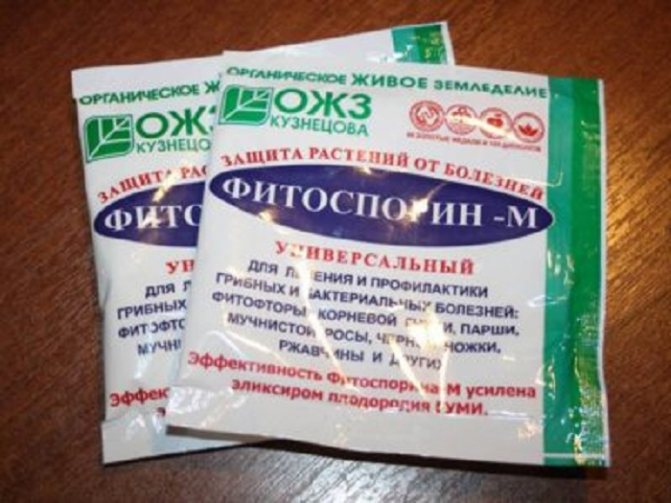

Biofungicides are effective for the prevention of fungal diseases and treatment at the initial stage of infection.
| Fitosporin (Alirin -analogue) | Effective against fusarium, bacterial, brown and black rot. With a solution of 10 drops in 1 liter of waterrub or spray the leaves. |
| Glyocladin | It is used for prophylaxis against a wide range of fungal and bacterial diseases. The tablet is placed in a substrate - 1 PC. for 300 ml. |
| Trichodermin | The drug is based on the antagonist fungus Trichoderma iignorium, which is harmless to plants, but dangerous to pathogens. For wiping and spraying, a ratio is recommended - 5 g of powder per 1 liter water. Processing can be carried out at any time of the year in different growing seasons. |
| Mikosan | The unique substance creates a protective film on the surface of the leaves, which does not allow pathogens to penetrate into the tissue. In addition, it stimulates the synthesis of protective enzymes by the orchid, due to which it is impossible for the infection to penetrate into the cells. For spraying or wiping the leaves, a working solution is required - 30 ml of concentrate per 1 liter of water. |
Photo
The photo shows what black and gray rot looks like on orchids.
What to do if leaf rot appears
Unfortunately, it is not always possible to avoid infection. And biological preparations help only in the initial stage of the development of rot. If the moment is missed and the disease has gone too far, more drastic measures will be needed.
- The affected leaf is partially removed if the stain is closer to the edge. The plate is cut to living tissue. In the case when the infection is located closer to the base, the sheet is cut off completely.
- Wounds are treated with fungicides to prevent the spread of infection.
- Whole leaves are wiped with a swab dipped in a fungicide solution.
Remedies that can save the plant
Chemical
- "Fitoverm" (or its analogues: "Aktofit", "Gaupsin") - the use of this drug does not harm a person, but has a detrimental effect on pests. The remaining solution must not be discharged into a pond or sewer. And it is better to burn the container in which the agent was diluted, but at the same time do not inhale the smoke that forms during combustion.
- "Actellik" - this remedy is usually used as a last resort, when "Fitoverm" or folk methods and remedies no longer cope.
Natural
IMPORTANT: The most common natural remedy for various infections, including fungal infections, is soap solution. Laundry soap is usually used for its preparation.
Diseased leaves, root system are treated with soapy water or they completely spill the soil with them. After treating the plant with soapy water, spray it several more times every five days for prevention.
Rot treatment with chemical fungicides
If these measures do not help, chemicals will be needed. They can only be used where there are no people or animals. In the summer, orchids are taken out into the garden and processed there. If this is not possible, then the plant should be sprayed on an open balcony.
Tip # 2... Always wear personal protective equipment when working with chemicals.
The following fungicides will help against putrefactive diseases:
| Bordeaux mixture | Includes slaked lime (fluff) and copper sulfate. It is used for spraying leaves. More effective at the onset of the disease. |
| HOM (copper oxychloride) | It has qualities similar to those of the Bordeaux mixture. |
| Speed | For spraying the leaves, prepare a solution of 2 ml of the drug per 1 liter warm water.If necessary, the session can be repeated, but not more than once. The likelihood of resistance is high, which means that the drug needs to be changed. |
| Fundazol | It is considered a powerful drug and is used to treat advanced diseases. For spraying orchid leaves, prepare a solution of one gram of powder per 1 liter of water. The total number of treatments should not exceed two times. |
| Topaz | The drug is preferable to use for the prevention of rot or when the first symptoms appear. The recommended concentration of the spray solution is 1 ml per 10 liters of water. |
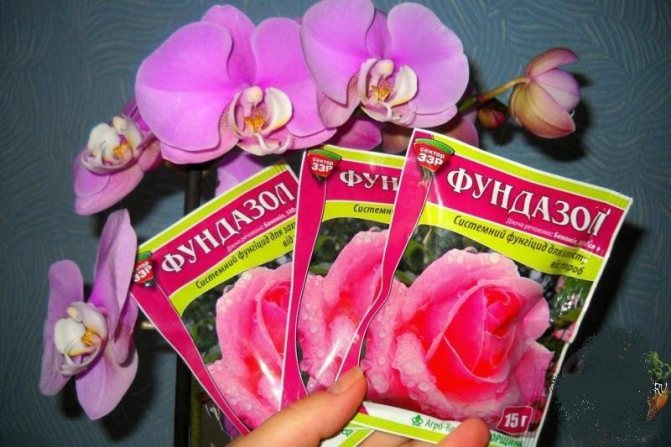

For the treatment of rot on orchid leaves, the same fungicides are used as for garden plants.
If the disease is caused by late blight fungus
This disease is very dangerous for the orchid, because it can destroy the plant in just a matter of days. Therefore, if this fungus is detected, you need to act immediately:
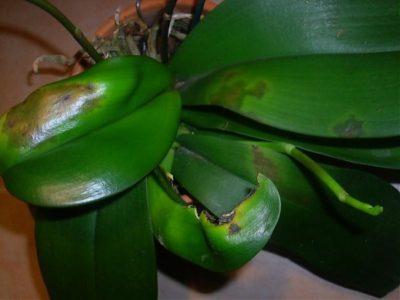

Isolate the affected flower from other healthy ones.- Prepare sharp scissors, knife or blade. Treat them with alcohol or hold them over a fire for a few seconds.
- Trim off any diseased areas and grab about 2 to 3 centimeters of healthy tissue.
- Sprinkle the cut areas with crushed charcoal or cinnamon.
- Wait for the wounds on the orchid to dry.
- Treat living areas with a fungicide.
Do not forget to treat the area where the infected orchid was.... You need to disinfect the pot itself, and just get rid of the soil.
Using fallen leaves
If the fallen leaves are from healthy plants, you can leave some of them in flower beds and flower beds. They will be an additional protection of the root system from frost and dryness, and the aerial parts of the plants will be slightly protected from the drying wind. In addition, decaying leaves fertilize the soil, enriching it with nitrogen, potassium, phosphorus, calcium, magnesium and other components.
In the case of evergreens, fallen leaves can be used as a layer of mulch to protect the roots. It is best not to leave them on the plants, as evergreens need access to light in winter. All fallen, not rotted leaves in the spring should be removed from the beds and beds during the first garden work.
Fallen leaves are home to many insects, molluscs and small mammals. The larvae wintering there are food for birds (blackbirds, robins, wrens), and many of them are our allies in the fight against garden pests (aphids, larvae). Decaying foliage ideal habitat earthwormsthat loosen the soil. Heaps of leaves, twigs and soil can serve as a home for hedgehogs that feed on pests.
Problem or dormant period
Let's start the discussion by looking at the cause of the “dormant period” that can occur in some orchids. Here's why the orchid sheds its leaves during this period. There are a large number of different types of orchids, due to which not only the conditions of detention, the appearance and color of the buds, but also the life cycle differ. The presence or absence of a dormant period is determined by the homeland of a particular plant, as well as climate and annual temperature changes.
It turns out that your plant can throw off all the leaves for the reason that in its homeland at this moment conditions become unfavorable, which is why the flower has a choice: go into hibernation or die. At the same time, your efforts will not give any result, respectively, an increase in temperature, the number of waterings, as well as fertilization will not bring the flower out of hibernation. Important! To know for sure whether your species has a hibernation period or not, find out the exact name of the species, and then read all the available information about it.On the other hand, the orchid can shed its leaves at the moment of rapid growth, which is not normal, since during this period the plant must accumulate useful substances, and the leaves must be used for photosynthesis, respiration, and evaporation of excess moisture. The lack of foliage makes the process of photosynthesis, respiration and moisture evaporation impossible, which has an extremely negative effect on the plant in general. It turns out that if the leaves have fallen off due to the presence of any problem, then the plant has every chance of dying. Problems can range from parasites to abnormal temperatures.
Effects


The appearance of yellowed parts of the exotic indicates various kinds of diseases or aging. The main danger is not to delay, but to react at the same time at the first symptoms. Provide assistance to a diseased plant in time, since the consequences are fraught with:
- complete drying of the roots;
- deterioration of the general condition against the background of infectious diseases;
- developmental disorder;
- cessation of flowering.
Note! There is a chance to revive a flower without a root system, but with leaves or vice versa.
The foliage turns yellow and subsequently falls off. The plant is in survival mode. And the loss of leaves is similar to the discharge of ballast, but the buds, blossoming flowers also fall, the peduncle dries up, and problems with the roots arise. This may indicate various, even serious, health problems. Especially if this happens in a fairly short period of time. We urgently need to find out the reason for the wrong.
Wrong neighborhood
To exclude all negative factors that can oppress the plant, you should pay attention to the content in everyday life, as well as what flowers live nearby. The orchid is capricious and demanding, loves light and space. If plants with heavy energy are its neighbors, then, experiencing stress, the entire leaf of the flower may fall. Representatives of the agave family (yucca, cordilina) and succulents growing nearby need to be moved to another room.
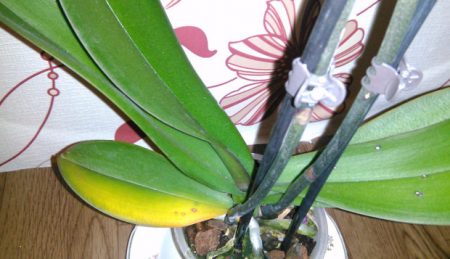

Output
Fallen foliage is a good material for mulching the garden and vegetable garden. After decomposition, it loosens the soil structure and makes it more fertile. but must be applied correctly
her, otherwise
instead of benefit
such mulch will only bring
harm
.
After reading the article, you learned:
- what can be mulched with fallen leaves;
- how to properly apply such mulch;
- in what cases its use can damage plants;
- that you can not mulch with fallen leaves.
Every experienced farmer and ordinary gardener is trying to get as much harvest as possible, while spending the minimum amount of money. That is why fertilizing of organic origin is so widely used in agricultural technology. In this article, we'll show you how to use fallen leaves as fertilizer.
Arid climate


Deciduous trees shed their foliage into drought to avoid drying out
In hot weather, the leaves evaporate a lot of moisture. The roots of the tree, supplying the leaves, lose a lot of water. Coniferous foliage, so-called. evergreen trees do not fall off, since their needles, occupying a small surface area, require less moisture compared to deciduous trees. Thus, deciduous trees shed their foliage during dry periods to reduce the need for moisture and avoid drying out.
Leaf picking tool
For cleaning and collecting foliage in small areas, it is best to use special fan rake, are metal or plastic, have fan-shaped teeth with flat ends. These rakes often have an adjustable tine spacing to adjust the tine width to the surface to be cleaned (for example, on a lawn or narrow beds). The fan rake efficiently collects leaves without damaging sod and plants.
For large surfaces, dedicated leaf blowers and vacuum cleaners are better suited (often one device combines the functions of a blower and a vacuum cleaner). Blowers blowing leaves in one place, which is certainly faster and more convenient than raking. Garden vacuum cleaners draws the leaves into a special container, they can also be equipped with a leaf crushing function. This reduces their volume quite significantly and promotes faster decomposition of the leaves, which is important, for example, when preparing leafy soil. The vacuum cleaner can be adapted to our needs and the size of the garden area taking into account, for example: the size and weight of the vacuum cleaner (for carrying on the shoulder, on wheels, with a drive), the type of engine (internal combustion or electric), the power (the more foliage to collect , the more powerful the engine), additional functions (blowing, suction, crushing leaves).
Features of the use of deciduous mulch
The main problem that sometimes makes it impossible to use fallen leaves to hide beds, a garden or a vegetable garden is associated with a high probability of falling into the mulch of leaves affected by various diseases or pest larvae
.
Bifidobacteria and fungi, which convert the deciduous mass into humus, as well as frost, cannot destroy pathogens and larvae, therefore, after the snow melts, bacteria and insects begin to look for food. Chances are good that they will be able to get to suitable plants and settle on them.
To prevent this from happening, it is necessary at intervals of 1-3 times a month check all plants
, trying to find affected leaves or branches on them.
If diseases or pests are found
, such branches / leaves
need to cut
from trees or shrubs, then fold where they cannot mix with falling foliage.
After autumn pruning, all disease-affected and pest-infested waste must be disposed of in one of these ways:
- take out
to the landfill; - recycle
for fuel cells; - burn
in compliance with fire and environmental safety requirements.
We wrote about whether it is possible to burn foliage on our site.
Also, do not use fallen leaves for mulching. coniferous plantations
, this can negatively affect the condition of the trees.
Such mulch will loosen the soil and make it more nutritious, but at the same time it will enter the soil. substances incompatible with the metabolism of conifers
... This will lead to a deterioration in the state of green spaces of the flesh to a drop in immunity and damage to various pests and diseases.
There is no such danger for any hardwood.
Testimonials
I bought the "Orchid. The dream has come true. Now I am studying special literature on nursing, as I am afraid of losing it. Thanks for the article, very informative. I received answers to all my questions.
Visiting a flower shop, I always admired Orchids. I could not take my eyes off their graceful beauty, but I did not dare to buy myself, I was afraid that I could not cope, because I always considered the flower to be very problematic. My family, knowing about my desire, gave me 4 pots with Orchids of different colors for my anniversary. There is no limit to my joy. So far, everything is with flowers. Every morning I communicate as with living beings and I love them very much.
I advise all grandmothers, when grandchildren are far away, from loneliness to start growing orchids. You have no idea how they changed my life. Constantly demanding attention and care, they distract from sad thoughts. You look at life in a new way, vigor and meaning of what you are doing appears. True, the price is expensive, but the beauty on the windowsill is worth it.
>
Mechanism of the phenomenon
What is the signal for plants to start falling leaves? This is a reduction in the length of daylight hours.Lower air temperatures and rainy weather are only accompanying the main reason.
The leaves change color, which causes the vessels to overlap. A layer of cells forms at the base of the petiole. It prevents the downward flow of water with sugars dissolved in it. As a result, anthocyanin pigments are formed, which change the color of the leaf blade. Over time, the base of the petiole dries up at the point of attachment to the shoot. Leaf fall begins.
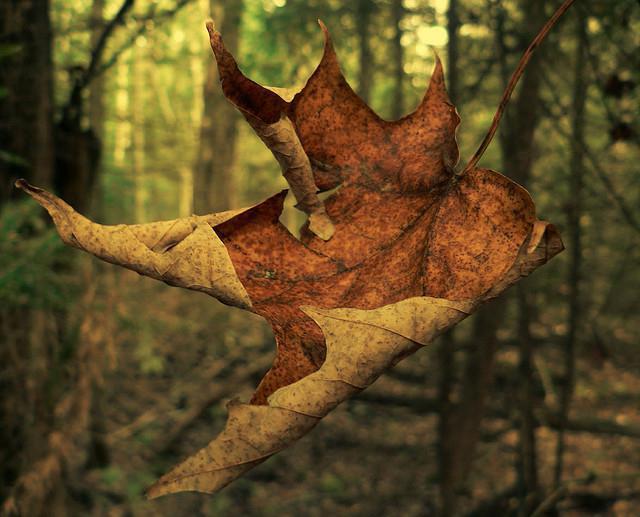

Pollination of trees
The shedding of leaves by trees also increases the efficiency of pollination of flowering plants. When there are no leaves on the branches, wind pollen spreads over large areas and, accordingly, covers more trees.
The answer to the question why leaves fall in autumn is obvious: falling leaves helps trees conserve energy and water, that is, it performs an energy-saving function and maintains the water balance in the plant's body. Shedding leaves is a way of adapting trees to weather conditions.
In addition, the fall of leaves on trees does not depend solely on climatic changes, it is a natural process laid down by nature in a biological cycle (indoor plants also shed leaves), which helps them to renew.
If you find an error, please select a piece of text and press Ctrl + Enter.


